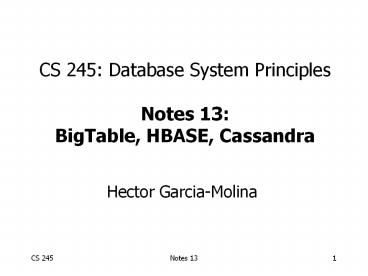CS 245: Database System Principles Notes 13: BigTable, HBASE, Cassandra - PowerPoint PPT Presentation
Title:
CS 245: Database System Principles Notes 13: BigTable, HBASE, Cassandra
Description:
CS 245: Database System Principles Notes 13: BigTable, HBASE, Cassandra Hector Garcia-Molina CS 245 Notes 13 * Sources HBASE: The Definitive Guide, Lars George, O ... – PowerPoint PPT presentation
Number of Views:149
Avg rating:3.0/5.0
Title: CS 245: Database System Principles Notes 13: BigTable, HBASE, Cassandra
1
CS 245 Database System PrinciplesNotes
13BigTable, HBASE, Cassandra
- Hector Garcia-Molina
2
Sources
- HBASE The Definitive Guide, Lars George,
OReilly Publishers, 2011. - Cassandra The Definitive Guide, Eben Hewitt,
OReilly Publishers, 2011. - BigTable A Distributed Storage System for
Structured Data, F. Chang et al, ACM Transactions
on Computer Systems, Vol. 26, No. 2, June 2008.
3
Lots of Buzz Words!
- Apache Cassandra is an open-source, distributed,
decentralized, elastically scalable, highly
available, fault-tolerant, tunably consistent,
column-oriented database that bases its
distribution design on Amazons dynamo and its
data model on Googles Big Table. - Clearly, it is buzz-word compliant!!
4
Basic Idea Key-Value Store
Table T
5
Basic Idea Key-Value Store
- API
- lookup(key) ? value
- lookup(key range) ? values
- getNext ? value
- insert(key, value)
- delete(key)
- Each row has timestemp
- Single row actions atomic(but not persistent in
some systems?) - No multi-key transactions
- No query language!
Table T
keys are sorted
6
Fragmentation (Sharding)
server 1
server 2
server 3
tablet
- use a partition vector
- auto-sharding vector selected automatically
7
Tablet Replication
server 3
server 4
server 5
primary
backup
backup
- CassandraReplication Factor ( copies)R/W
Rule One, Quorum, AllPolicy (e.g., Rack
Unaware, Rack Aware, ...)Read all copies (return
fastest reply, do repairs if necessary) - HBase Does not manage replication, relies on HDFS
8
Need a directory
- Table Name Key ? Server that stores key
? Backup servers - Can be implemented as a special table.
9
Tablet Internals
memory
disk
Design Philosophy (?) Primary scenario is where
all data is in memory. Disk storage added as an
afterthought
10
Tablet Internals
tombstone
memory
flush periodically
disk
- tablet is merge of all segments (files)
- disk segments imutable
- writes efficient reads only efficient when all
data in memory - periodically reorganize into single segment
11
Column Family
12
Column Family
- for storage, treat each row as a single super
value - API provides access to sub-values(use
familyqualifier to refer to sub-values e.g.,
priceeuros, pricedollars ) - Cassandra allows super-column two level
nesting of columns (e.g., Column A can have
sub-columns X Y )
13
Vertical Partitions
can be manually implemented as
14
Vertical Partitions
column family
- good for sparse data
- good for column scans
- not so good for tuple reads
- are atomic updates to row still supported?
- API supports actions on full table mapped to
actions on column tables - API supports column project
- To decide on vertical partition, need to know
access patterns
15
Failure Recovery (BigTable, HBase)
ping
master node
tablet server
sparetablet server
memory
write ahead logging
log
GFS or HFS
16
Failure recovery (Cassandra)
- No master node, all nodes in cluster equal
server 1
server 3
server 2
17
Failure recovery (Cassandra)
- No master node, all nodes in cluster equal
access any table in clusterat any server
server 1
server 3
server 2
that server sends requeststo other servers
18
Bonus SlidesAre Traditional Databases Dead?
- Heard on Twitter
- noSQL rules
- new DB systems scale better than old ones
- DBMS too slow ...
- Therefore, need new, revolutionary technology!!
WARNING Author may be biased -)
19
Cautionary Tale
- Lawrence Richard Walters, nicknamed "Lawnchair
Larry" or the "Lawn Chair Pilot", (April 19, 1949
October 6, 1993) was an American truck driver
who took flight on July 2, 1982 in a homemade
aircraft. Dubbed Inspiration I, the "flying
machine" consisted of an ordinary patio chair
with 45 helium-filled weather balloons attached
to it. Walters rose to an altitude of over 15,000
feet (4,600 m) and floated from his point of
origin in San Pedro, California into controlled
airspace near Los Angeles International Airport.
20
Parallels
- Lawnchair Larry
- Wanna fly
- Cant afford airplane
- T-Gen
- Wanna DB services
- Cant afford real DBMS
21
Parallels
- Lawnchair Larry
- Wanna fly
- Cant afford airplane
- I can do myself!
- I am off!!
- T-Gen
- Wanna DB services
- Cant afford real DBMS
- I can do myself!
- I am off!!
22
Parallels
- Lawnchair Larry
- Wanna fly
- Cant afford airplane
- I can do myself!
- I am off!!
- How do I land???
- T-Gen
- Wanna DB services
- Cant afford real DBMS
- I can do myself!
- I am off!!
- I need joins???
23
Parallels
- Lawnchair Larry
- Wanna fly
- Cant afford airplane
- I can do myself!
- I am off!!
- How do I land???
- How talk ATC?
- How to navigate?
- Need oxygen!!??
- T-Gen
- Wanna DB services
- Cant afford real DBMS
- I can do myself!
- I am off!!
- I need joins???
- How to index?
- Just had crash! Now what?
- Data inconsistent!
- Oh? Need to maintain???
24
Keep Lawnchair Larry in Mind
- Does DBMS technologynot cut it and we need
tostart from scratch?? - Or are you just being cheap? ?
- If you think you need a subset of DBMS, will
needs change over time?































